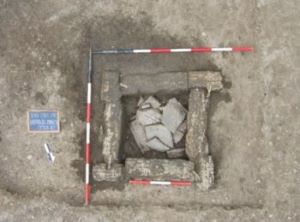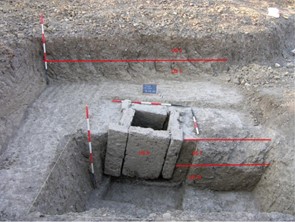All entries for Tuesday 21 September 2021
September 21, 2021
Burying a Lightning Bolt, by Jon Madge
 |
 |
| Photo edited (cropped) from Manconi, D., & Spiganti, S. (2017). ‘Un fulgur conditum a Todi (Umbria)’. OTIVM, 3: Figure 4.1 (pg.20). | Photo from Manconi, D., & Spiganti, S. (2017). ‘Un fulgur conditum a Todi (Umbria)’. OTIVM, 3: Figure 6.1 (pg.22) |
In 2010, an excavation carried out by the Soprintendenza Archeologica per l’Umbria (SAR) in the town of Todi (Umbria) revealed a quadrangular structure dated to the late 2nd century AD, consisting of worked travertine slabs and reinforced at the corners with iron clamps. The structure was capped with two large slabs (118 x 60 x 18cm and 117 x 60 x 18cm) bearing the inscriptions FVLGVR and CONDITVM, which indicated that the archaeologists had discovered a Roman monument marking the ritual burial of a lightning bolt (fulmen condere).
 |
Photo from Manconi, D., & Spiganti, S. (2017). ‘Un fulgur conditum a Todi (Umbria)’. OTIVM, 3: Figure 10.1 (pg.26) |
This practice originally derived from the Etruscan art of lightning divination (disciplina fulguralis) and its specialised procedure was likely defined in Libri Fulgurales, a sacred text supposedly revealed by the nymph Vegoia. It, along with many other fulgural traditions, was adopted by the Romans because they recognized the Etruscans as masters of lightning divination from as early as the 3rd century BC.
Literary sources can shed light on the discovery at Todi. They tell us that following a lightning strike, a priest (a member of the sacerdotes bidentales) was required to perform a purification rite on the land to acknowledge the divine fulgural message, as well as sanctify the site. In doing so, the ritual served to preserve a healthy relationship with the gods. The 1st-century AD poet Lucan, for instance, mentions a venerable Etruscan seer named Arruns, who suggested the Romans expiate a lightning omen by collecting the scattered fires of the thunderbolt and burying them in the earth (B. Civ. 1.584–637. Cf. Apul. De deo Socr. 7; Schol. Pers. 2.26). It was an integral part of the ritual: any material objects damaged by the lightning were to be retrieved and consecrated to the gods by burying them in a pit or small enclosure, a bidental, which visually commemorated the lightning omen. Evidence for this practice can be seen at Todi: within the structural cavity (60 x 60 x 90cm) the archaeologists discovered 712 meticulously placed marble pieces (of varying sizes and shapes), as well as fragments of metal, pottery, and bone. Some of the marble fragments, thought to have lined the walls of a nearby building, even showed signs of heat damage – possibly as the result of the lightning strike.
The grammarian Festus (probably of the 2nd century AD) provides further details that support these interpretations. He tells us that the ritual involved sacrificing a two-year-old lamb on the site. Indeed, the obscure name ‘bidental’ derives from the Latin word bidens, which literally means ‘having two teeth’ but typically relates to the age of the sacrificial animal (Gloss. Lat. 30.15-19 L. Cf. Macrob. Sat. 6.9.5). Of the animal bones that were discovered at Todi, some belonged to sheep (of undetermined age) and had been charred, perhaps as part of the ritual.
Furthermore, Ammianus Marcellinus tells us that the sacred ground on which the lightning fell was to neither be looked at nor trodden on (23.5). The find at Todi also bears witness to this tradition. Firstly, the large slabs of travertine placed on all sides sealed the structure and prevented view of the collected contents. Secondly, while the monument itself dates to the late 2nd century AD, related contexts (the date of which was determined by material finds) suggest that part of the structure remained above ground for a long period of time, preventing people from stepping over it.
On multiple levels, then, the monument discovered at Todi can correlate with our understanding of the ritual as presented in the literary sources and, moreover, it helps piece together the various snippets of information they collectively describe. The structure and its contents thus allow the literary and material evidence to work together to better our understanding of a diverse range of topics: about the nature of space and the transformation of space into sacred ground, about the adoption of Etruscan religious practices in Rome, about how natural phenomena were seen as supernatural, as well as about the public and private performing of rituals, and many others. As new examples of fulgura condita are discovered, it only broadens the capacity for what we can learn. Indeed, across Europe, hundreds of examples have already been discovered. Most are identified by a simple tile inscribed fulgur conditum or as an acronym (FCS = Fulgur Conditum Summanium; FDC = Fulgur Dium Conditum), but in some cases, such as at Todi, the monument and its contents are more substantial. In the Casa dei Quattro Stili (House of the Four Styles) at Pompeii, for example, a hollow in the ground was discovered in 1939, filled with fragments of tiles, utensils, cement and stucco, all of which lay beneath a small mound of beaten earth and a broken tile inscribed FVLGVR (Maiuri 1942: 56-72; Van Andringa et al. 2010). Another lightning burial was excavated in 1941, in the southwest corner of the peristyle of a house at Ostia, subsequently named the Domus Fulminata, the House of the Thunderbolt (Van der Meer 2005). Here, a marble plaque was discovered, inscribed with the letters FDC and this time the chamber was filled with fragments of terracotta tiles, glass, the handle of an amphora, an unrecognisable bronze artefact, and a section of pavement. Other examples have been excavated in the Roman colony of Minturnae (Degrassi 1971: 123-127), at Vulci (Buranelli 1991: 161–166), Luni (Frova 1973: 820-830), and near the Theatre of Pompey (Pietrangeli 1949-1951: 44-52), to name but a few examples.
The similarities in their form and function over many centuries and locations therefore attest to the ritual's widespread significance in Roman culture. For archaeologists and ancient historians, this is particularly exciting because our understanding of this significance will continue to develop as more lightning burial monuments come to light.
Bibliography
Buranelli, F. (1991) “Il «fulgur conditum» di Vulci” in Gli scavi a Vulci della società Vincenzo Campanari-Governo Pontificio (1835-1837), L’Erma di Bretschneider, Roma: 161-163.
Degrassi, A. (1971) “Il bidental di Minturno” in Scritti vari di Antichità, Società Istriana di Archeologia e Storia Patria, Trieste: 123-127.
Frova, A. and Bertino, A. (1973) Scavi di Luni: relazione preliminare delle campagne di scavo, 1970–1971. Roma, L'Erma di Bretschneider.
Laubry, N. (2016) "Les « Coups De Foudre » De Jupiter Et L'exportation De La Religion Romaine En Gaule" in Gallia 73, no. 2: 123-44.
Manconi, D, and Spiganti, S. (2017) “Un fulgur conditum a Todi (Umbria)” in Otium 3: 1–40.
Maiuri, A. (1941) “Fulgur conditum o della scoperta di un bidental a Pompei” in Rendiconti della R. Accadema de Archeologia Lettere e belle Arti, 21: 53-72.
Pietrangeli C. (1949-1951) “Bidentalia”, RPAA, XXV-XXVI: 37-52.
Turfa, J. M. (2012) Divining the Etruscan World: the Brontoscopic Calendar and religious practice. Cambridge University Press.
Van Andringa, W. et al. (2010), “Pompeii: Le fulgur conditum de la maison des Quatre Styles, I, 8, 17) in The Journal of Fasti Online, accessed (03.08.21): http://www.fastionline.org/excavation/micro_view.php?fst_cd=AIAC_2532&curcol=main_column
Van der Meer, L. B. (2005) “Domus Fulminata. The House of the Thunderbolt at Ostia (III, VII, 3–5)”, in Bulletin van de Antieke Beschaving 80: 91–111.
Weinstock, S. (1951) “Libri Fulgurales” in Papers of the British School at Rome (New Series Volume 6), 19: 122-153.
 |
This post was written by Jon Madge, a final year PhD researcher of Classics and Ancient History at the University of Warwick. His thesis explores the interaction between politics and celestial omens – lightning, comets, and luminary optics – from Caesar’s assassination in 44 BC to that of Domitian in AD 96. |
 Jacqui Butler
Jacqui Butler

 Please wait - comments are loading
Please wait - comments are loading
 Loading…
Loading…